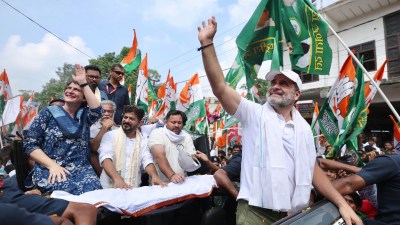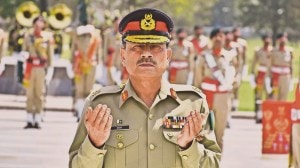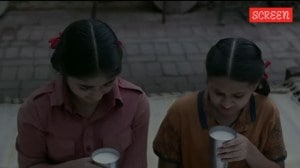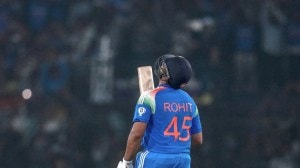In Croatia, a Roma conference ponders whether the community can be termed Indian diaspora
In the context of India’s foreign policy and its plans to give recognition to the Roma community, that would mean giving identification to the approximately 25 million people spread around the world, affiliated to various Roma social groups.
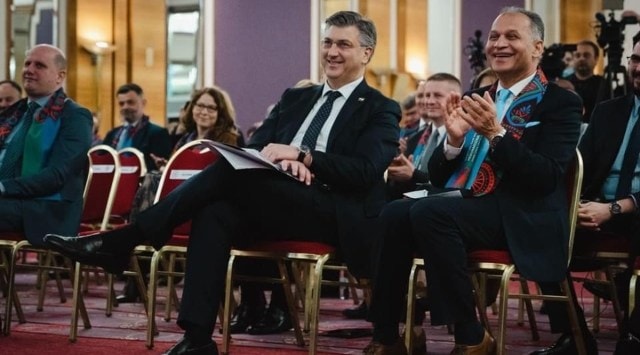 The first day of the Roma conference in Zagreb, Croatia, was attended by Croatia’s Prime Minister Andrej Plenković, Veljko Kajtazi, member of the Croatian Parliament, Roma leaders and India’s Ambassador to the Republic of Croatia, Raj Kumar Srivastava. (Express photo)
The first day of the Roma conference in Zagreb, Croatia, was attended by Croatia’s Prime Minister Andrej Plenković, Veljko Kajtazi, member of the Croatian Parliament, Roma leaders and India’s Ambassador to the Republic of Croatia, Raj Kumar Srivastava. (Express photo)In October last year, the Indian Council for Cultural Relations (ICCR) had announced that the Republic of Croatia would be hosting an international conference in its capital Zagreb just two days after International Romani Day on April 8 this year. Then, weeks before the two-day conference, the organisers notified that the discussions would focus on a unique subject: Roma as the Indian diaspora.
The ICCR’s announcement had come after a visit by the organisation’s director-general Dinesh K. Patnaik to Zagreb, where he had met with Veljko Kajtazi, member of the Croatian Parliament, also the former president of Kali Sara, an organisation of the Romani people in Croatia.
🗞️ Subscribe Now: Get Express Premium to access the best Election reporting and analysis 🗞️
India’s policies
The Indian government’s engagement with the Roma community on a diplomatic level, though sporadic, should not come as a surprise, Dr. Atanu Mohapatra, a professor at Central University of Gujarat’s Centre for Diaspora Studies, told indianexpress.com. In 1983, at a Roma conference in Chandigarh, Indira Gandhi had praised and acknowledged the community, saying that she felt “kinship with the Roma community”. Close to two decades later, in 2001, at a major international Roma conference organised with support from the Indian government, former Prime Minister Atal Bihari Vajpayee had met with community leaders, making it the second diplomatic engagement on the issue at such a high level by India.
In 2016, India’s former foreign affairs minister Sushma Swaraj, delivering the inaugural address at the International Roma Conference and Cultural Festival, said that the Roma were “perfect flag-bearers of Indian ethos”. Weeks after this address, in April 2016, Member of Parliament in the Lok Sabha, Bhola Singh, tabled a starred question asking whether the “Roma people constitute the Indian diaspora” and whether any study had “been proposed to discover the roots or origin of the Roma people.”
Historical documentation indicates that the migration of the Roma started sometime around the 5th century from what is now north-west India, during the invasion of Alexander, who took back with him large numbers of expert iron smiths, particularly from nomadic groups in the region, like the Doms, Banjaras, Chauhans, Gujjars, Sanchis, Dhangars and the Sikligars.
In 2016, the Minister of State in the Ministry of External Affairs, Gen. V. K. Singh (Retd.) had responded to Singh’s question, saying that the objectives of the Roma conference “was to re-establish cultural and linguistic links with the Roma community, review existing scholarly studies…and (to) encourage further studies.” At that time, in Gen. Singh’s response, there was no mention of any plans by the Indian government to recognise the Roma as a part of the Indian diaspora.
On the first day of the conference on Monday, attended by Croatia’s Prime Minister Andrej Plenković, Roma leaders and India’s Ambassador to the Republic of Croatia, Raj Kumar Srivastava, Kajtazi’s address said that one of the goals of this conference was to answer the question of what the community’s Indian origin means to the Romani today and what the community wants from India. “Will cultural and occasional collaboration suffice or should we take the next step and request that we as a people receive some form of formal legal and political recognition?” Kajtazi asked.
Historical experiences
From the community’s perspective, there are no easy answers, Kajtazi admitted in his address, in part because the Roma are dispersed all over the world. Citizenship, identity and belonging remain important issues for the community because of collective trauma and complex historical and socio-cultural factors. The community has historically faced prejudice, violence, discrimination and racism in several parts of the world and have been denied equal opportunities in the fields of healthcare, education, housing, employment, government services, recognition etc., and continue to battle exclusion and social deprivation.
Alen Tahiri, director, Government Office for Human Rights and Rights of National Minorities in Croatia, believes that some reasons why the Roma community continues to face these difficulties is because “it is perhaps unrealistic to expect that almost a 1,000 years of injustice can be solved within a decade, or two or three.”
Tahiri points to the persecution of the Roma during the Second World War and how the community’s sufferings were ignored. “It took many countries many years to recognise Samudaripen—the persecution of the Roma for being Roma—while being very much aware of the Holocaust or the persecution of some other groups. Stereotypes and prejudices are deeply entrenched, and for many Roma it is impossible or very difficult to break out of the vicious circle of interrelated factors such as marginalisation, discrimination, poverty, lack of education, poor health and housing,” he said.
Some researchers believe the Roma, particularly those in Europe, are among the groups most vulnerable to statelessness in the region. This is where the discussions surrounding identity and recognition by a nation-state become important to the community, because they are linked with the community’s history of persecution, and how their subsequent lack of trust of authorities has continued.
“Not registering children at birth, because it is mostly done in hospitals, where many Roma women gave birth at home for various reasons; then mobility, particularly during the time of conflicts—including the most recent wars in Croatia, Bosnia and Kosovo—are among many factors contributing to the problem. The problem in Croatia is of a far smaller magnitude than it is in many other countries, but (it is still significant),” Tahiri said. The Roma in Europe are frequently found to be among the most discriminated groups in many countries, including in member states in the European Union.
There has been little research exploring links between the Roma and the Indian subcontinent, Tahiri agreed, in part because of the complexities of the subject. In India, there is still little awareness and knowledge about the Roma community, and more importantly, of their historical experiences. But that may be changing, albeit slowly, with the Indian government taking more interest in the community, especially over the last few years.
“Since 2016, there has been an attempt to organise biennial conferences on Roma issues and similarly organise Roma cultural festivals in the intermittent years. The Indian Council for International Cooperation has set up a Centre for Roma Studies and Cultural Relations, whose primary objective is to develop long-term relationships with Roma community institutions, civil society organisations and NGOs,” India’s Ambassador to Croatia, Raj Kumar Srivastava, stated in his address at the conference. One of the goals of this centre, Srivastava said, is to cooperate with different Roma organisations “to challenge stereotypical views against them.”
 India’s Ambassador to Croatia Raj Kumar Srivastava speaking at the Roma Conference in Zagreb, Croatia. (Express photo)
India’s Ambassador to Croatia Raj Kumar Srivastava speaking at the Roma Conference in Zagreb, Croatia. (Express photo)
What diaspora means
The meaning of the term ‘diaspora’ has evolved over the years, Dr. Mohapatra said. “Diaspora does not always mean that the group has an objective to return to the homeland but rather that the group hopes to communicate and have a connection with the homeland.” In an academic context, when categorising a group as a diaspora, common traits are sought for classification. In the case of the Roma community, the group migrated many centuries ago and over the years, have integrated with the countries where they settled, while still holding on to their unique cultural practices. But a closer look into these cultural practices show their links with the Indian subcontinent.
“I believe that they can be given the Indian diaspora status, or the status of the extended diasporic community or the ancient diasporic community, because they migrated long ago,” Mohapatra explained. “They are certainly unique in terms of the groupings of diasporic communities.”
Kajtazi told indianexpress.com that the identification of the Roma as part of the Indian diaspora would apply to the community across the world. “This is the reason why the conference has an international character with Roma representatives present in person from 17 different countries,” he said.
Kajtazi believes that formal identification of the Roma as part of the Indian diaspora would mean more opportunities for the community, implying that it would also result in exchanges with their counterparts in India, particularly in the fields of education and business. “Roma are present in many countries and they historically see India as their ancient homeland. As the status of Roma improves in the western world, the idea of formalising this connection is being discussed even more,” Kajtazi said.
In the context of India’s foreign policy and its plans to give recognition to the Roma community, that would mean giving identification to the approximately 25 million people spread around the world, affiliated to various Roma social groups—a massive task.
What is not clear is precisely how this recognition would collectively help all Roma, across the world, which may be a reason why the Indian government is yet to produce a concrete vision for its plans, Mohapatra explained. Existing schemes like the Overseas Citizenship of India (OCI cards), have several rules which may not necessarily apply in the case of the Roma. “The extended diasporic status can certainly be given. But, what next?” Mohapatra asked.
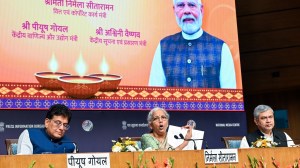



- 01
- 02
- 03
- 04
- 05


